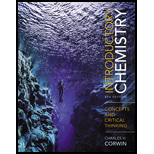
(a)
Interpretation:
The systematic name for the binary ionic compound,
Concept introduction:
The IUPAC system of naming is used to provide a proper naming to the binary ionic compound. According to this system of naming, the cation of the binary ionic compound is named as the same as an atom and the oxyanions of the compound is named as oxide.
(b)
Interpretation:
The systematic name for the binary ionic compound,
Concept introduction:
The IUPAC system of naming is used to provide a proper naming to the binary ionic compound. According to this system of naming, the cation of the binary ionic compound is named as the same as an atom and the oxyanions of the compound is named as oxide.
(c)
Interpretation:
The systematic name for the binary ionic compound,
Concept introduction:
The IUPAC system of naming is used to provide a proper naming to the binary ionic compound. According to this system of naming, the cation of the binary ionic compound is named as the same as an atom and the oxyanions of the compound is named as oxide.
(d)
Interpretation:
The systematic name for the binary ionic compound,
Concept introduction:
The IUPAC system of naming is used to provide a proper naming to the binary ionic compound. According to this system of naming, the cation of the binary ionic compound is named as the same as an atom and the oxyanions of the compound is named as oxide.
Want to see the full answer?
Check out a sample textbook solution
Chapter 6 Solutions
Introductory Chemistry: Concepts and Critical Thinking Plus MasteringChemistry with eText -- Access Card Package
- Suppose an element from group II(A)(2) and period 3 of the periodic table forms an ionic compound with an element that has an electronic configuration of 1s22s22p5. What would be the formula of the compound, and what would be the name of the compound?arrow_forwarddisilicon pentaselenide, is it ionic or covalent?arrow_forwardPlease answer and provide solution clearly and accurately. periodic table of elements is provided. I will leave thumbs up onced accomplishedarrow_forward
- Write Correct formula for the following hodgepodge of compoundarrow_forwardWhich noble gas is known as stranger gas?arrow_forwardAmmonium nitrate is an inexpensive source of nitrogen content used to enrichfertilizers. Although when handled improperly, it could be dangerous andcatastrophic. What is the chemical formula for ammonium nitrate?arrow_forward
- Generally in which direction on the periodic table does the ionic radius tend to decrease?arrow_forwardd, an ionic solid like sodium chloride consists of discrete pairs of sodium cations and chloride anions. True or false whyarrow_forwardWhich of the following is not a ternary ionic compound: potassium nitride, potassium nitrate, or potassium nitrite?arrow_forward
- Alum is a(n) ……………….. compound which means that in the solid state ……………………. are held together by ………………………….. and form ……………………………………… structuresarrow_forwardWhat property is used to separate the copper sub-group (II-A) from the tin sub-group (II-B)? Identify then illustrate with a balanced ionic equationarrow_forward
 Chemistry for Today: General, Organic, and Bioche...ChemistryISBN:9781305960060Author:Spencer L. Seager, Michael R. Slabaugh, Maren S. HansenPublisher:Cengage Learning
Chemistry for Today: General, Organic, and Bioche...ChemistryISBN:9781305960060Author:Spencer L. Seager, Michael R. Slabaugh, Maren S. HansenPublisher:Cengage Learning Introductory Chemistry: An Active Learning Approa...ChemistryISBN:9781305079250Author:Mark S. Cracolice, Ed PetersPublisher:Cengage Learning
Introductory Chemistry: An Active Learning Approa...ChemistryISBN:9781305079250Author:Mark S. Cracolice, Ed PetersPublisher:Cengage Learning Living By Chemistry: First Edition TextbookChemistryISBN:9781559539418Author:Angelica StacyPublisher:MAC HIGHER
Living By Chemistry: First Edition TextbookChemistryISBN:9781559539418Author:Angelica StacyPublisher:MAC HIGHER World of ChemistryChemistryISBN:9780618562763Author:Steven S. ZumdahlPublisher:Houghton Mifflin College Div
World of ChemistryChemistryISBN:9780618562763Author:Steven S. ZumdahlPublisher:Houghton Mifflin College Div



